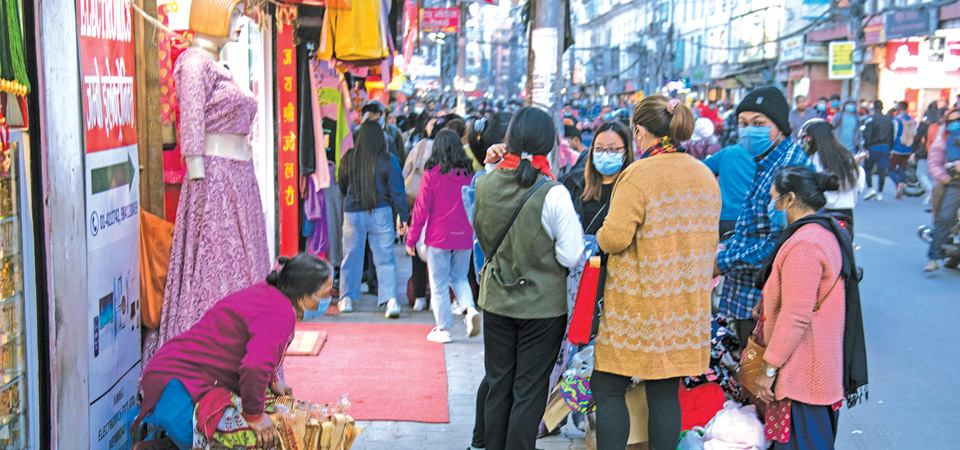Managing street vendors still a hard nut to crack

Kathmandu, Mar. 21: A proper footpath is hard to be seen in Kathmandu and those available are mostly crowded – not just with pedestrians, but also with street vendors. However, this is nothing new.
What’s new, however, is that the numbers of street vendors have only been increasing over the years.
Maya Gurung, central chairman at Nepal Street Vendors’ Union, informed that there were around 35,000 vendors across the Kathmandu Valley earning their livelihood from the streets.
“Managing street vendors have received priority only in words. Some initiation was taken around two decades ago, but failed to gain traction,” said Gurung.
During the 2017 local level elections, Kathmandu’s Mayor Bidya Sundar Shakya had said that the management of street vendors was one of his priorities.
Five years later, a new local level election is around the corner and the problems remain the same.
Without a roof, people are found selling different items from early morning till evening in the footpaths of Kathmandu on a daily basis regardless of the weather conditions. From drinking water, clothe clips and cotton buds to clothes, books and electronics, street vendors sell it all.
“Kathmandu has changed a lot. From a few people on the streets back then, there are only people all around now. Still only a bunch of individuals stop to buy from me,” said an 86-year-old man who was selling loofah sponges at Rs. 20 per piece along the footpath of New Road on Saturday afternoon. Nearby the elderly were two youths selling posters, a disabled man on a wheelchair selling common things like nail cutter, clippers, combs and shoe polish among others and a woman with a weighing machine and water bottles.
“The ones working as street vendors are mostly people with disabilities, senior citizens and single women. Even youths are working part-time. It is all because of poor education and economic condition,” said Gurung.
She added, “Many come to Kathmandu from corners of the country just to earn a livelihood by selling stuffs on the streets.”
A government committee, more than a decade ago, had also recommended relocating street vendors to Khulamanch, Tinkune ground, Balaju and Kalanki. It fell on the deaf ears of the new leadership.
“New governments with new people in leadership forgot about the initiation taken to manage street vendors. We have met with people in federal, provincial and local levels – but to no avail,” said Gurung.
Street vendors argued that the government had done nothing for them.
“Many large buildings have been constructed for different purposes over the years. We have not been provided a small space yet,” said Man Bahadur Karki, a street vendor who has been selling clothes along the footpath of New Baneshwor for more than five years now.
While footpaths are filled with street vendors, buyers and pedestrians, the adjoining street has a queue of pushcarts selling similar things alongside fruits and vegetables. The scenario is common in areas like Ratnapark, New Baneshwor, Sundhara, Koteshwor, Kalanki, Gaushala, Sinamangal and Maitidevi among others.
Concerned authorities like Kathmandu Metropolitan City and other local levels in the Valley have also been warned by Gurung that they will struggle to manage street vendors in future if they continued doing nothing.
“The number of street vendors will only increase in the Kathmandu Valley because of economic reasons. Lack of management will only worsen the problem,” said Gurung.
Street vendors have also been leading to traffic congestion along several major roads in the Valley during the evening. Pedestrians also struggle to walk properly.
“The problem of street vendors is visible and we want its proper management. Verbal discussions and meetings have been conducted with stakeholders to find a solution but nothing concrete has been initiated yet,” said Ishwor Man Dangol, spokesperson for Kathmandu Metropolitan City.
Recent News

Do not make expressions casting dout on election: EC
14 Apr, 2022
CM Bhatta says may New Year 2079 BS inspire positive thinking
14 Apr, 2022
Three new cases, 44 recoveries in 24 hours
14 Apr, 2022
689 climbers of 84 teams so far acquire permits for climbing various peaks this spring season
14 Apr, 2022
How the rising cost of living crisis is impacting Nepal
14 Apr, 2022
US military confirms an interstellar meteor collided with Earth
14 Apr, 2022
Valneva Covid vaccine approved for use in UK
14 Apr, 2022
Chair Prachanda highlights need of unity among Maoist, Communist forces
14 Apr, 2022
Ranbir Kapoor and Alia Bhatt: Bollywood toasts star couple on wedding
14 Apr, 2022
President Bhandari confers decorations (Photo Feature)
14 Apr, 2022











